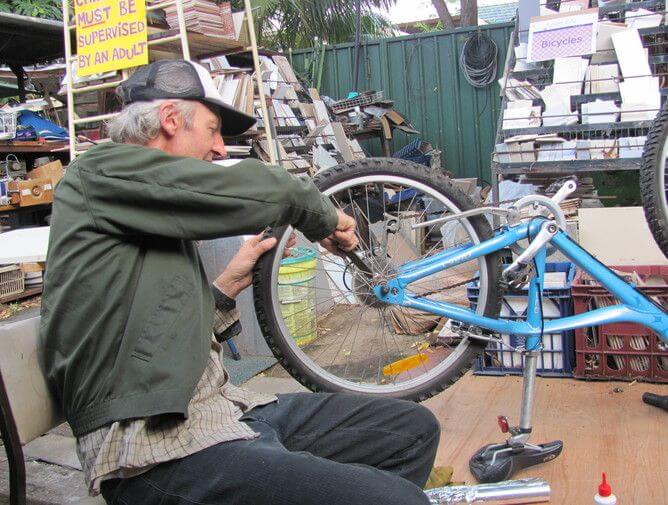作者/ Jade Herriman
編譯/ 陳采華
[tabs]
[tab title=”中文”]
維修咖啡館 能修補的東西超出你預期
試想,若你的智慧型手機螢幕碎裂,腳踏車輪胎彎曲變形,或是最愛的那雙靴子破了洞,你會怎麼做?當然你可能直接買新的,或者你也可以跟上潮流,帶著壞掉的物品到「維修咖啡館」去重修舊好。
澳洲環保組織Bower Reuse and Repair Centre剛在雪梨西區開了澳洲第一間維修咖啡館,這家由群眾募資所開設的咖啡館,於每週不同時段為腳踏車、家具以及電子產品提供維修服務。
2009年,全世界第一家維修咖啡館於荷蘭阿姆斯特丹成立,而根據維修咖啡館基金會表示,已經有超過400家的維修咖啡館開設於全球各地。
什麼是維修咖啡館?
維修咖啡館提供給具有維修技能的志願者,以及有需要修理物品的當地居民免費面對面交流的機會。大多時候會在當地工作室、社區中心、當地市集,以及公園擺設攤位等,「可以隨時造訪」的空間來提供週修、月修或是季修的服務。此外,民眾不單單只是將家裡壞掉的物品帶來,在這裡他們會觀摩甚至學習如何修理直到工作完成。有些東西會在活動當下修好,而對於較具挑戰性的品項,人們大多轉向當地維修專門店。
維修志工不一定是專業技工,但是他們熱愛修東西。如同許多人只是喜愛腳踏車,而在過程中進一步學會保養與維修;喜愛縫紉的人會縫縫補補、修改老舊的衣服;還有一些人對手錶的運作充滿興趣。

澳洲第一間維修咖啡館座落於雪梨西區。
除了因為興趣外,維修是必須深入了解後而學會的技能,也是帶來莫大成就感的創新過程。這也是為什麼許多曾光顧的顧客最後都成為了志工。
在維修咖啡館成功修復的品項清單很多:腳踏車、衣物、相機、行動電話、電腦、除草機、行李箱、燈具、烤麵包機、光碟播放機、微波爐 — 基本上,差不多所有你能帶去的東西都能修理。
為甚麼要修理?直接買新的不就好了?
現在人們對物質的觀念有著極大的變化,從老一輩的「能修就修」一直到現今的「壞了就丟」。簡易的修理 ─ 像是修補鞋子、縫補洋裝破洞、把斷了的椅子黏起來…都越來越少見。為了生活便利,用完就丟的觀念越來越深,從刮鬍刀、筆等小型用品一直延伸到服飾、傢俱以及電子產品。漸漸的,廉價大量生產使人們產生東西不夠好就該丟掉的觀念,維修被認為是件退流行又沒有必要的事。
根據澳洲國家統計局的數據來看,去年澳洲全國丟棄了超過50萬噸的皮革與布料製品,遠遠超過了回收利用的十倍量。但英國研究指出,回收舊衣減少了人類對環境所造成的衝擊,同時也促進社會平等。
修理文化

修理東西其實很有趣。
修理代表著對時下用完即丟文化概念的對抗。維修咖啡館提供人們談論,促進交流的機會,並學習運用當地資源。也許對認為修理是苦差事的人們來說會很驚訝,但維修咖啡館不但有趣且充滿創意。
在加州帕羅奧圖一次的活動後,主辦者在他的部落格寫道:「來維修咖啡館的人都很開心。這似乎代表我們真的引起共鳴,不僅激起他們對修理的熱情,也提升了人們對社區參與的意願。同時透過人與人之間的關係,如與其他當地團體及社區維修中心等的合作,激發出許多不同的想法,並相互建議下一次如何做會更好。最重要的是,「每個參與者都很開心。」同時,來自英國的主辦者強調:修理不但有創意且富含政治性,還是能力與獨立的象徵,亦是凝聚社區意識及減少資源浪費的方式之一。
創客運動(Maker Movement)、駭客空間(Hackerspace)和其他業餘玩家、學生與DIY狂熱者的崛起,是這波21世紀DIY風潮興起的另一項證明。這些與維修咖啡館的服務品項相較之下,象徵其他小眾專業化漸漸崛起。像是Remade in Edinburgh,著重在服飾與工藝品;Free Geek Chicago及倫敦的Restart Project皆專精於手機電子產品的修復與升級,而不用再破費買新的。現在網路上都可以找到很多關於維修的資源,從基本的縫補衣物到複雜的電腦、手機、相機甚至是卡車的維修教學。有些維修愛好者更以維修代替購買做長達一年的自我挑戰。
這是循環經濟,傻瓜!
維修咖啡館的創辦人Martine Postma說過:「在循環經濟中,維修咖啡館融入得恰到好處。」維修拒絕「買─用─丟(buy-use-dispose)」模式,目標讓資源不斷回收利用,而非壞了就丟。.
倫敦的The Restart Project 談到他們在循環經濟中的小貢獻,像是維修物品,分享技能,讓回收利用達到最大值,並將維修與保養變成當地經濟開發的一部份。也許丟掉壞掉的東西是最簡單快速的方法,但這麼做不但花錢,也少了原本該有的驚喜。
【Author:Jade Herriman】
雪梨科技大學首席研究員,長期投入永續發展相關議題。
[/tab]
[tab title=”English”]
Repair cafes are about fixing thingsincluding the economy
Imagine your smartphone’s screen gets smashed, or your bike wheel gets buckled, or your favourite boots get a hole in them. What do you do? You could buy a replacement. Or you could join the worldwide trend of taking your broken stuff to a “repair café”.
The Bower Reuse and Repair Centre has just launched Australia’s first repair café, in Sydney’s inner west. The crowd-funded project will hold weekly repair sessions focusing on bikes, furniture and electrical items.
The first repair café was set up in Amsterdam in 2009, and the Repair Café Foundation says there are now more than 400 around the world.
What is a repair café?
A repair café is a free face-to-face meeting of skilled volunteers and local residents who want things fixed. Many run as a weekly, monthly or seasonal “drop-in” space at a local workshop or community centre, or offer stalls at a local fair or park. Visitors bring broken items from home and watch, learn or help as the repairs get done. Some things are fixed during the event, while for more challenging items people might be referred to local speciality repair shops.
Volunteers aren’t necessarily tradespeople but they are tinkerers – people who love to work with objects. Many people who love bikes have learned how to repair and maintain them; others can sew, alter and transform old clothes; still others are fascinated by how watches work.

Up and running in Sydney’s inner west. Jade Herriman, CC BY
In this sense, repair is a natural extension of understanding, and a creative process that gives immense satisfaction. Many visitors to repair cafés end up becoming repairers themselves.
The list of items successfully repaired at repair cafés is huge: bikes, clothing, cameras, mobile phones, computers, lawnmowers, luggage, lamps, toasters, CD players, microwaves – basically, almost anything you can physically bring along.
Why bother?
Our relationship with material objects has changed dramatically in the generations since wartime Britons were told to “make do and mend”. Simple repairs – resoling a shoe, mending a hole in a dress or gluing the leg of a chair – became less common as the disposable culture developed beyond small items like razors and pens, to include clothes, furniture and electronics. Mending came to be seen as old-fashioned and unnecessary, and cheap mass-production meant that anything less than perfect could be thrown away and replaced.
Last year, according to the ABS, Australians sent more than half a million tonnes of leather and textiles to landfill – more than ten times the amount that was reused or recycled. But as British researchers conclude, reusing old clothes reduces environmental impact and boosts social equity.
A culture of repair

Fixing things can be fun. Jade Herriman, CC BY
Mending represents a deliberate attempt to resist the throwaway culture. Repair cafés get people talking and give them the chance to network and learn about the local resources available. And, perhaps most surprisingly for anyone who considers mending to be some kind of frugal drudgery, repair cafés can be fun and creative. After one event in Palo Alto, California, organisers wrote on their blog:
Visitors to the Repair Cafe were delighted. It seems we really struck a chord with people – not only touching their desire to do something positive about their accumulated, broken stuff, but also appealing to the desire people have for this kind of community participation. The event also sparked lots of ideas among different people who came by – partnerships with other community groups, a community tool library, and advice on how to do things better next time. Most of all, though, everyone just had fun.
Meanwhile, repair café organisers in Brighton, UK stress that:
Repairing is not only a creative and political activity – creating a sense of empowerment and independence – it is also a way of creating community cohesion and reducing waste.
New approaches to old stuff
This wave of 21st-century DIY enthusiasm is also evident in the rise of the Maker Movement, Hackerspace and other networks for hobbyists, students, or enthusiasts.
While repair cafés are general, other similar projects are more specialised, such as Remade in Edinburgh, which focuses on clothes and crafts, and Free Geek Chicago and the London-based Restart Project, which help people repair and upgrade their own phones and electronics without buying new ones.
Online, there is a host of resources about repair – from the basics of mending clothes, to detailed and complex repair guides for computers, phones, games consoles, cameras, and even trucks. Some “fixers” have challenged themselves to make it the entire basis of their lifestyle.
It’s the circular economy, stupid
“In a circular economy, repair cafés fit right in”, says the movement’s original founder Martine Postma. In rejecting the linear model of buy-use-dispose, the circular economy aims to keep resources moving around in the economy, rather than shunting them through it to a dead end, where they are lost to valuable use.
The Restart Project describes efforts such as theirs as the “inner circle of the circular economy” – small-scale solutions that involve sharing skills to develop a local economy of maintenance and repair, before items are even considered for recycling.
It might be quicker and easier to throw stuff in the bin, but it’s more expensive and less fun too.
【Author:Jade Herriman】
Jade is a Research Principal at University of Technology Sydney. She has 15 years experience in sustainability research and project management, with a background in environmental biology and applied environmental management in local government.
[/tab]
[/tabs]
圖片來源:《The conversation》
原文經合作媒體:《The conversation》授權編譯,未經許可不得轉載
